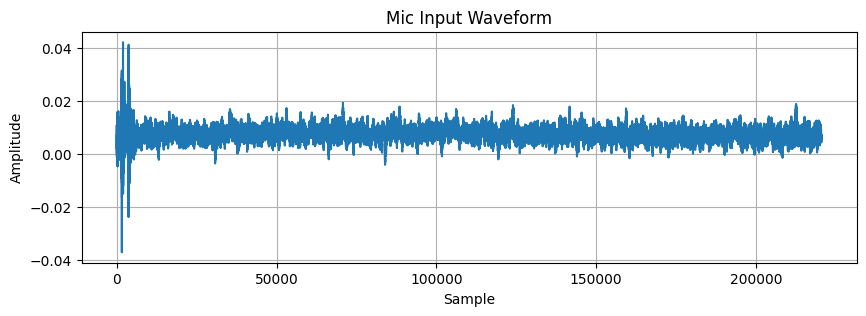✅ Overview: What You’ll Do
- Record audio from the mic
- Visualize the waveform
- Play it back
- (Optional) Run basic analysis (volume, noise floor, frequency)
🧰 1. Install Required Python Libraries
pip install sounddevice numpy scipy matplotlib ipython
These tools use your system’s microphone input and work across platforms.
🎙️ 2. Record Audio from Microphone in Jupyter
import sounddevice as sd
print("Available audio input devices:")
devices = sd.query_devices()
for i, device in enumerate(devices):
if device['max_input_channels'] > 0:
print(f"[{i}] {device['name']} — {device['hostapi']}")
Available audio input devices:
[0] UM02: USB Audio (hw:1,0) — 0
[5] HD-Audio Generic: ALC897 Analog (hw:3,0) — 0
[7] HD-Audio Generic: ALC897 Alt Analog (hw:3,2) — 0
[8] UGREEN camera 2K: USB Audio (hw:4,0) — 0
import sounddevice as sd
import numpy as np
from scipy.io.wavfile import write
# Recording parameters
samplerate = 44100 # Hz
duration = 5 # seconds
print("Recording...")
recording = sd.rec(int(samplerate * duration), samplerate=samplerate, channels=1)
sd.wait()
print("Recording complete.")
# Save to WAV file
write("mic_test.wav", samplerate, recording)
Recording...
Recording complete.
✅ You now have a 5-second recording from your default microphone.
🔊 4. Playback in Notebook (Optional)
from IPython.display import Audio
Audio("mic_test.wav")
🎧 This plays your mic test right in the notebook.
🧪 5. Basic Mic Quality Metrics
RMS Volume:
rms = np.sqrt(np.mean(recording**2))
print(f"RMS Volume: {rms:.4f}")
Noise Floor Estimate (first second):
noise_sample = recording[:samplerate] # First 1 second
noise_rms = np.sqrt(np.mean(noise_sample**2))
print(f"Estimated Noise Floor: {noise_rms:.4f}")
Estimated Noise Floor: 0.0082
🧠 Advanced Options (Optional)
| Plot frequency spectrum |
Use FFT via numpy.fft.fft |
| Record stereo or longer |
Change channels=2 or duration=10 |
| Test multiple mics |
Use sd.query_devices() and device=... |
| Clean noise |
Use scipy.signal, librosa, or noisereduce |
| Transcribe speech |
Use speech_recognition or whisper |
📋 Summary Workflow
1. 🎙️ Record with sounddevice
2. 📦 Save as WAV
3. 📊 Plot waveform
4. 🔊 Playback with IPython
5. 🧪 Measure volume / noise
Would you like: - A downloadable Jupyter notebook template for mic testing? - A version that tests and compares multiple microphones side-by-side?
Let me know how deep you want to go — I can add frequency analysis or even ML-based speech quality scores!
Back to top
